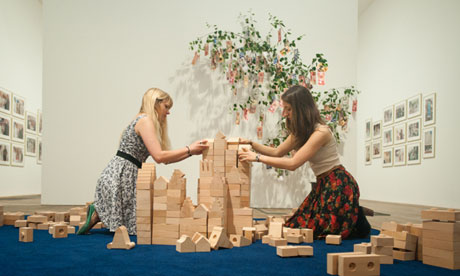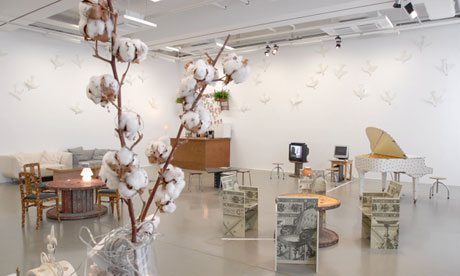The art of Meschac Gaba
Making space
A “Museum of Contemporary African Art” opens at Tate Modern
 A movable feast
A movable feast
This, at least, is the vision of Meschac Gaba, a leading African artist. His playful “Museum of Contemporary African Art” goes on display on July 3rd at London’s Tate Modern, which bought the work last year. An epic five-year project, from 1997 to 2002, Mr Gaba’s 12-room “Museum” is designed to be provocative. It is his “fight to make a space for African art,” he explains. In the absence of a real museum, he decided to create one himself.
Born in Benin in 1961, a year after the country gained independence from France, Mr Gaba is part of a generation of African contemporary artists making work that considers the challenges of creating a post-colonial identity. His is a motley mix of local craft and European aesthetics, with references to Africa’s oppressive history and current poverty.
Mr Gaba’s own life and career as an artist straddles the cultural divide his work seeks to bridge. Married to a Dutch curator (in a ceremony chronicled in the Marriage Room of his “Museum”), he spends half the year in Rotterdam, the other half in his native Benin. He began making art there, taking everyday life as his subject. “I didn’t know of the existence of contemporary art,” he says.
His breakthrough came when he began using decommissioned bank notes in work about money and politics, which won him acclaim locally and abroad. In 1992 Mr Gaba was invited to exhibit at the Musée des Arts d’Afrique et d’Océanie in Paris, as well as in neighbouring African countries. He then went on to study art at the Rijksakademie in Amsterdam, where he believed there would be fewer preconceptions about African art than if he had studied in France.
Yet he was frustrated by the lack of gallery space designated for the kind of conceptual art he and fellow African artists were making. “There would be just one corner for contemporary African art in an ethnographic museum,” he says with a chuckle. “People did not understand that African art could be experimental.” And so in his second year at the Rijksakademie he had the idea of his “Museum”. It took a series of European museum residencies and exhibitions to realise all 12 rooms. Some were then shown at the 2002 Documenta art show in Kassel in Germany.
Mr Gaba’s “Museum” is interactive and wryly amusing. The Architecture Room invites visitors to build their own museum from children’s bricks; the Game Room to play with puzzles. The Library features the artist’s own books, as well as some old computers running on bike-generated electricity. The Tate acquired the work as part of a two-year programme to spotlight contemporary African art. This was pivotal for Mr Gaba, who had resisted selling the work piecemeal; he spent years living with his family in his large, cold studio, with his “Museum” in boxes all around him. Perhaps, he says, this “will open up possibilities for other African artists”.
*****
Meschac Gaba's anti-museum shows the strength of modern African art
Forget
ancient ceremonial sculpture, Beninese artist Meschac Gaba's playful
Museum of Contemporary African Art at Tate Modern reveals how African
art is often overlooked

Museum of Contemporary
African Art … employees interact with part of Meschac Gaba's
installation at Tate Modern, London. Photograph: Piero
Cruciatti/Barcroft Media
It was in the Marriage Room that Meschac Gaba's
vision tore through my expectations of what art is and how it relates
to our ordinary, irreplaceable lives. This room in the Beninese artist's
Museum of Contemporary African Art is full of wedding souvenirs, from photographs to gifts, that record his marriage to a Dutch curator in a ceremony at the Stedelijk Museum in Amsterdam.
Art or life? It was both. And today, that joyous conflation of reality with the cool precincts of a museum is commemorated in a soppy wedding video and love tokens displayed as museum artefacts in London's Tate Modern. It got me hooked on the strange and wonderful nature of Gaba's enterprise.
At the Museum of Contemporary African Art you can sit on sofas and read books, play a piano, see Ghanaian money with Picasso's face on it, or visit a Swiss bank that looks like an African street market. Through an epic assembly of often poignant stuff runs a confessional thread, as the artist narrates his journey through the world of modern art, between Africa and Europe and back again.
In the Library, where books on a vast range of modern art are available to consult, you can hear about Gaba's childhood, how he drew all over his reading books. His passion for art eventually led him to study at the Rijksakademie in Amsterdam. Personal information is not extraneous to this exhibition – it's an unavoidable part of it.
 Meschac Gaba's Music Room, part of his Museum of Contemporary African Art. Photograph: Nils Klinger
Museums can be autobiographies, or novels. The Museum of Contemporary
African Art is a bit of both. But it is also a protest. Where is the
African art of today in European and American museums? The Art and
Religion Room juxtaposes reproductions of "classic" African religious sculpture with tacky Christian and Buddhist artefacts. The stress that museums place on African ceremonial art of the past, this implies, is a bit like judging modern European art by kitsch replicas of Raphael Madonnas.
Meschac Gaba's Music Room, part of his Museum of Contemporary African Art. Photograph: Nils Klinger
Museums can be autobiographies, or novels. The Museum of Contemporary
African Art is a bit of both. But it is also a protest. Where is the
African art of today in European and American museums? The Art and
Religion Room juxtaposes reproductions of "classic" African religious sculpture with tacky Christian and Buddhist artefacts. The stress that museums place on African ceremonial art of the past, this implies, is a bit like judging modern European art by kitsch replicas of Raphael Madonnas.
Where, he asks, is the contemporary voice of Africa in our museums?
It's here, in this powerful surrealistic anti-museum. The homemade quality of everything in the Museum of Contemporary African Art gives it a raw atmosphere of living cities. The excitement and complexity of our sprawling century seems to press at the doors. Traditionally, museums put art in a quiet world of its own. This one opens the window and lets in the noise.
Art or life? It was both. And today, that joyous conflation of reality with the cool precincts of a museum is commemorated in a soppy wedding video and love tokens displayed as museum artefacts in London's Tate Modern. It got me hooked on the strange and wonderful nature of Gaba's enterprise.
At the Museum of Contemporary African Art you can sit on sofas and read books, play a piano, see Ghanaian money with Picasso's face on it, or visit a Swiss bank that looks like an African street market. Through an epic assembly of often poignant stuff runs a confessional thread, as the artist narrates his journey through the world of modern art, between Africa and Europe and back again.
In the Library, where books on a vast range of modern art are available to consult, you can hear about Gaba's childhood, how he drew all over his reading books. His passion for art eventually led him to study at the Rijksakademie in Amsterdam. Personal information is not extraneous to this exhibition – it's an unavoidable part of it.
 Meschac Gaba's Music Room, part of his Museum of Contemporary African Art. Photograph: Nils Klinger
Museums can be autobiographies, or novels. The Museum of Contemporary
African Art is a bit of both. But it is also a protest. Where is the
African art of today in European and American museums? The Art and
Religion Room juxtaposes reproductions of "classic" African religious sculpture with tacky Christian and Buddhist artefacts. The stress that museums place on African ceremonial art of the past, this implies, is a bit like judging modern European art by kitsch replicas of Raphael Madonnas.
Meschac Gaba's Music Room, part of his Museum of Contemporary African Art. Photograph: Nils Klinger
Museums can be autobiographies, or novels. The Museum of Contemporary
African Art is a bit of both. But it is also a protest. Where is the
African art of today in European and American museums? The Art and
Religion Room juxtaposes reproductions of "classic" African religious sculpture with tacky Christian and Buddhist artefacts. The stress that museums place on African ceremonial art of the past, this implies, is a bit like judging modern European art by kitsch replicas of Raphael Madonnas.Where, he asks, is the contemporary voice of Africa in our museums?
It's here, in this powerful surrealistic anti-museum. The homemade quality of everything in the Museum of Contemporary African Art gives it a raw atmosphere of living cities. The excitement and complexity of our sprawling century seems to press at the doors. Traditionally, museums put art in a quiet world of its own. This one opens the window and lets in the noise.
沒有留言:
張貼留言